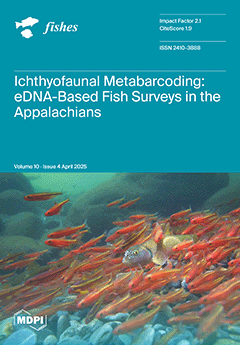Replacing fishmeal (FM) with plant-based protein sources remains a significant challenge, particularly for carnivorous fish. This study investigates the effect of dietary
Lentinus edodes fermentation (LEF) supplementation on Japanese eel (
Anguilla japonica) fed with fermented soybean meal (FSM) as a partial
[...] Read more.
Replacing fishmeal (FM) with plant-based protein sources remains a significant challenge, particularly for carnivorous fish. This study investigates the effect of dietary
Lentinus edodes fermentation (LEF) supplementation on Japanese eel (
Anguilla japonica) fed with fermented soybean meal (FSM) as a partial FM replacement. The positive control consisted of 64% FM (Con), and the negative control (FSM group) included 52% FM plus 12% FSM. Two experimental diets were formulated by adding 2% LEF (LEF2 group) and 3% LEF (LEF3 group) to the negative control diet. The experimental diet was administered to Japanese eels weighing 62.50 ± 2.14 g for 12 weeks. The experimental fish were randomly assigned to four groups, with three replicates of 100 fish per group. The results indicated that growth performance and feed efficiency were significantly reduced in the FSM group, but were significantly improved by LEF supplementation (
p < 0.05). LEF supplementation did not significantly affect muscle crude fat and protein content compared to the FSM group (
p > 0.05), but significantly increased muscle amino acid content and levels of certain fatty acids (linoleic acid, γ-linolenic acid, eicosatrienoic acid, DHA) (
p < 0.05). LEF supplementation reduced serum TC and LDL-C levels, increased HDL-C levels, significantly increased CAT and T-SOD activities, and reduced MDA levels in both serum and liver (
p < 0.05). ALT and AST activities were significantly elevated in the FSM group, accompanied by liver histological abnormalities, which were improved by LEF supplementation. LEF supplementation increased the thickness of the muscularis, villus height, and goblet cell count in the intestine (
p < 0.05). Compared to the control, the FSM group significantly upregulated spleen
tnf-α gene expression and downregulated the expression of anti-inflammatory factors (
ifn-α,
ifn-γ,
socs1,
mavs). LEF supplementation ameliorated the reduced immunocompetence induced by FM replacement with FSM by enhancing the expression of immune-related genes (
irak4,
ifn-α,
ifn-γ,
irf3,
irf11,
socs1,
mavs,
traf3) in the spleen. These results suggest that the beneficial effects of LEF supplementation on growth performance and feed efficiency may be attributed to its improvement of liver damage and intestinal histology, as well as its enhancement of antioxidant capacity and immunity.
Full article





